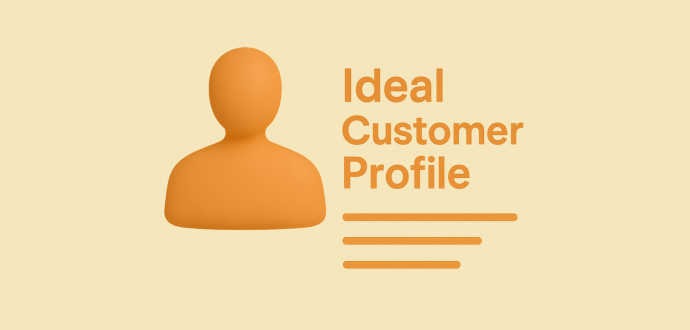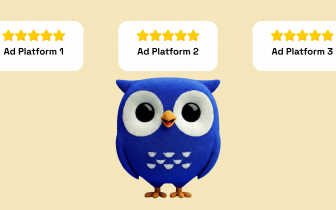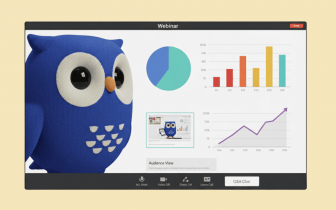How to Build Your Ideal Customer Profile Template (+9 Examples)

There are tons of acronyms in marketing, but few are as overused and misunderstood as this one: ICP. Way too often, it’s reduced to something very generic and simple: “B2B software companies with 50–200 employees.”
Well, is it actually enough? Can you identify your perfect client with just this description?
The answer is obvious — not at all.
The truth is, creating a working ideal customer profile (ICP) template requires hard work. It has to be extremely specific and narrow, otherwise it just won’t work.
To help you avoid situations like this, we’ve prepared this guide with several examples to help you make the most of it.
Is an ICP the same as a buyer persona?
Since both ICP and a buyer persona serve complementary purposes, it is tempting to think that they interchangeably refer to the same thing. Well, that is not true.
Yes, both help you understand your target audience. But they do it differently.
A buyer persona template is more of a fictional representation of your potentially real customer.
It’s that profile where you say: “This is Bob. He is an art director at the design agency. And he needs an easy solution to give instant feedback to his designers.”
A customer profile template, on the other hand, helps you define your perfect target company (for B2B) or a whole audience segment (for B2C).
If we go back to the Bob example, it could look like: “A US-based design agency with 100-200 employees in staff and $1M+ in revenue that needs an effective tool for in-team communication and task management.”
So, ICP is basically a concept you need for broader strategies, sales, and product-market fit. At the same time, a buyer persona is a person you speak to in your content and messages.
Why do you need a client profile?
As ICP helps you define the most valuable clients, it can be really beneficial in many ways:
Get higher efficiency in lead generation
This comes mostly from the fact that you get to know and focus on those who have a higher chance of converting. Imagine that you used to rely on ads across all social media platforms without any good results.
Then you learned from your customer profiling that it's the clients on LinkedIn who actually interact with and buy your products. Well, now, you can reduce waste from running ads on platforms that don’t bring results and focus on LinkedIn promotion.
Achieve personalized messaging that raises sales rates
Thanks to your more accurate and in-depth understanding of who your buyers are, you can create a more targeted and personalized brand messaging that they can resonate with .
Apart from the obvious benefits, your content will perform better in terms of SEO since it matches search intent and users’ needs. As a result, you can get more responses to your content and get more leads.
Raise satisfaction rates and encourage brand loyalty
Beyond closing more deals, understanding your customers can lead to them feeling more satisfied with your brand experience.
But this can only work when you make them feel seen and heard. This is critical as it directly impacts and encourages brand loyalty and your overall image.
People who feel like you get them are also more likely to recommend your business to their friends and family.
Create better campaigns and marketing strategies
While marketing is full of guessing, having the right data helps you make better marketing decisions (and yes, better guesses).
You will still need to test different hypotheses and angles, but your data will point you in the right direction. Otherwise, it can turn into a never-ending testing process that leads nowhere.
Knowing your customers won’t tell you what kind of campaigns will give you the desired results. But it will definitely simplify your job and give you ideas about the best content formats and distribution channels.
Improve cross-team collaboration
When you have clear frameworks, it becomes easier to share profiling data across various teams.
Think of it this way — the marketing team has one perspective when it comes to your prospects. But sales and CS rely on different data sources and have two absolutely different views .
So, when you have a process of defining your perfect clients, everyone knows how to contribute and share their take. As a result, your ICP template goes beyond some random framework. It turns into a document that everyone wants to check out for better outcomes in their own area.
This way, everyone is in the loop and aligned with what the clients’ needs are, and what's the best way to engage with them.
After all, customer profiling is how you get to align what you do with what people need.
But how do you find those ideal clients in the first place?
How to find your perfect clients
Of course, before you even get into creating any template, you need to have a clear process in place that helps you find those ideal buyers.
The easiest approach here is to analyze your current clients to see who seems like a perfect (or almost perfect) fit. Then, describe them in lots of detail. This is basically your first ICP — congrats!
Yet, if it seems too subjective and complicated to understand who your best clients are, you can use the following ideal customer profile scorecard.
You can tweak it according to your business needs, but the idea is clear — analyze different client groups/companies to find that ideal fit.
Depending on how you structure your offering, your ICPs can be very different. Some of them might simply be smaller sub-profiles, while others could describe an absolutely different group in your customer base.
That’s why, apart from collecting data, you also have to analyze it and define clear client segments. This can often take more time than you think, so don’t get too frustrated.
What types of data should you include in your profile?
To build a good framework, you’ll need not just a large volume of data but the right kind of it. This includes:
#1 Demographics
Demographics is the usual info that you would find on the ideal buyer profile template. It includes surface-level details such as age, gender, income, education, job roles, marital status, etc.
Still, this shouldn’t be the main focus of your ICP because while it’s important, it won’t be a defining factor in your further strategies (in most cases).
This kind of data simply helps you segment your audience, choose your distribution platforms, formats, etc. But this can only help you deliver your message, not create it.
Basically, it superficially answers the question, "Who is your customer?"
#2 Psychographics
Now that you have the “who” questions settled, the next one is the “why.” Why do they buy your products or services? Psychographics data gives you the answer to that.
Source: Semrush
This type of information helps you understand your clients’ personality traits, their values, and beliefs. It also shows you what their lifestyle is like and what religion and political affiliations they have.
As a result, you get to know their opinions about different issues and their overall preferences and worldview.
The only challenge is that you can't really measure this type of data, unlike demographics. Still, it is the most valuable information that you will have in your customer profile. Why?
Because it helps you understand what motivates people to buy from you. Besides, it tells you how they perceive you and who is more likely to stick with your brand for the long haul.
#3 Geographics
Geographics is the data about your clients’ location — what a surprise, right?
It is super important for your SEO, ad campaigns, language options available on your website, etc. But beyond that, knowing your clients’ region gives you an idea about their cultural norms, slang, and the overall perception of different things.
So, yes, of course, geo is something really basic. Yet, it is also essential.
#4 Behavior
Every successful company tracks its customers’ purchase history, feedback, and how they use its website. People’s behaviors are key to their emotions. While you can’t get into their heads to know what they feel and think (thankfully), you can still track what they do.
If you use good tools and have enough data, you can understand what your clients really want, how they pick products/services, and why some of your tactics don’t work.
This can give you an understanding of how to tweak your offering, how to market it, and how to improve your conversions.
Overall, this is often more important than basic demographics because it gives you real insights, not your assumptions.

#5 Company-level
If you are a company that targets other businesses (B2B), you need firmographic data for your client profile template. When selling to companies, you want to know their industry, number of employees, yearly revenue, business location, and other basics.
But go beyond just those obvious details. Try to understand how they’re structured, what their true goals and values are, etc. The more you understand how their firm operates, the easier it will be to convince them that you are their best solution.
Source: Datarade
You will need a lot of data to make your ICP actually useful for your campaigns, content, sales, and communications. If you don’t collect enough information, your profile won’t have any value because doing it for the sake of it makes no sense.
To avoid those useless profiles, check the following tips.
6 steps to create an ideal customer profile template
Approaching framework creation can seem dull and complex. But it shouldn’t be if you know the following:
Step 1: Skip the hassle by using a framework
Here's the hard truth — creating an ICP from scratch can be a huge pain. But you can also skip all of that hassle by simply looking for one online that matches your needs.
Spoiler alert: You’ll also get nine different client profile examples below.
You will still have to tweak any framework you find because every business is different. But it is a great starting point in any case.
Still, if you prefer to DIY your own template, the following tips are for you.
Step 2: Put in the work during research
It's nearly impossible to create any kind of useful customer profiling template without accurate data. So, if you want the right kind of information, then you need to put in the work. You want to do thorough research to get the complete picture about your dream and current clients.
But how can you gather all these insights? There are many ways available to you, including:
Website analytics
Every company serious about its growth analyzes visitors' behavior on its website. It’s extremely helpful to figure out:
- Which content gets the most engagement,
- Where visitors click,
- Which CTA drives the most conversions, etc.
Ideally, you want to do the same (if you aren’t already). There are many even free tools like Google Analytics that can take the guesswork out of this process for you.
Source: Google
With this knowledge, you can create a copy that will be relatable for your clients, one that will make them feel something. This can work for both B2C and B2B copywriting, by the way.
Surveys and interviews
Actually asking your clients gives you a chance to hear directly what they think and what they really want. One of the most obvious ways to do that is with interviews and surveys. These are just some of the things you can ask them about:
- Their worries,
- Their motivations to buy products like yours,
- Their needs for such products or services,
- The challenges they face,
- How you can help them, etc.
You can easily use templates from SurveyMonkey (or any similar solution) to structure your questions and make them more attractive.
Source: SurveyMonkey
Social media
Social media has become one of the best tools for many use cases. One of them is tracking engagement. You know, monitoring comments, shares, likes, feedback, etc.
But beyond that, you can also use social media listening tools to know how people perceive your brand and your content. Even how they compare you to your competitors.
Source: Hootsuite
With all this data, you will gain a more accurate picture of who your buyers are and what motivates their buying habits.
Review sites
Review sites are perfect for getting an idea about your clients and their true opinions.
Think of Trustpilot, Yelp, Google Business Profiles, and so on. These are gold mines for knowing how people perceive your product and services, as well as other brands that offer the same thing as you.
Source: Trustpilot
With that feedback, you can always improve your service/product. Plus, you will know what features other brands are not adding to their offering (if you check their listings). Then, you can add them to yours to attract a larger customer base.
The more insightful data you have, the easier it will be for you to create an ICP that is actually representative.
Step 3: Know the data you need and which one isn’t a priority
While we emphasize that it’s important to collect a lot of data, it doesn’t mean that you have to track everything and anything. Not at all.
Every business has relevant insights and the ones that aren’t a priority (or simply useless ones). This will mostly depend on your niche and the customers you target, but also on your goals at any given moment.
For example, a B2C business that offers coffee will focus on behaviors that show lifestyle preferences and shopping habits. So, they need to mostly consider psychographics and demographics.
At the same time, this kind of data will only paint an incomplete picture for enterprise-level B2B brands.
Say you are a B2B SaaS company. Then, you have to get lots of firmographic details for your ideal customer profile template. You want to know the yearly revenue of the companies you're targeting, their employee count, who the decision-makers are, etc.
Step 4: Structure your framework right
You've put a lot of work into identifying an ideal client. Now, what should your ICP framework look like? Clear and easy. You don't want anything that is complicated and confusing.
It should take only a glance to get all the major information.
Mostly, you'll notice that many templates have headers with the name. This is followed by a summary of demographics, geographical details, etc. Then, you'll likely have insights about their pain points, motivations, goals, their buying journey, and so on.
All of this should be broken down into sections to improve readability. But the main point here is to create a framework that gives you all the data you need. So, feel free to add anything that you find relevant, even if most don't.
Step 5: Add many details to the profile
When creating the customer profile, it's better to add as many details as you can and need. As we’ve mentioned before, simply adding demographics might be quite useless or at least not informative enough to draw any conclusions.
For example, using “an 18-36 year old social media savvy early adopter of AI trends on TikTok” is definitely more descriptive than just dropping the age range.
This info will come in handy when you're building a sales and marketing strategy to match their interests.
Of course, you'll have to make sure that everyone on your team (across departments) is updated with this profile. The sales team needs it to find the best leads and persuade them, the customer support needs it to understand buyers' needs better, and so on.
Step 6: Refine your profiles and findings regularly
When you are done with your target market profile template, don't think your work ends here. You see, market trends are constantly changing. That means that your clients are also reacting and adjusting their preferences.
So, you will need to review and refine your data all the time. This is why you have to clearly understand what metrics matter for your business. Based on them, you can build and tweak your frameworks to make them reflect the current market reality.
9 ICP templates and what we can learn from them
Ready for the fun part? Here are nine target customer profile examples and what they can teach us:
#1 Basic/universal
While it’s hard to create a universal framework that works for every business out there, here is a basic option that can become a good foundation for your company.
This is a simple, easy-to-scan template. It has all the most important sections that you can expand as you see fit.
#2 Behavior-based
Sometimes, you might want to group your potential customers based on their behavior. It’s no secret that people who buy from you act differently.
Some don’t like to be bothered at all and would prefer to do the business without even talking to anyone. Others will gladly participate in most of your initiatives.
If you feel like you have customer segments like this, the following framework might work for you.
#3 B2B
The B2B profile template mostly focuses on several firmographic details that are absolutely essential when assessing your target companies. It gives you an understanding of how you can help your target business and get them to pick you as a result.
Besides, thanks to this doc, your marketers can know what content (demos, case studies, etc.) to prioritize in your strategy. And your sales team will have a better idea of what to focus on when communicating with prospects.
#4 B2C
While a typical ICP is mostly focused on a target company, which is applicable to B2B, a B2C customer profile will concentrate on a particular client segment. There could be a variety of options for how you decide to structure your template.
So, just pick the focus that works for you now, and you can change it later on.
#5 Comparison
This type of consumer profile template helps you compare different segments of your ideal prospects. It can be especially helpful for strategic team sessions where you want to make sure you cover the needs of every segment.
Many businesses also use it when creating a specific campaign to see how their focus should vary depending on each group.
#6 Psychographic-based
This is the kind of profile template that helps you humanize your customers. It changes your perception of them from an abstract idea to more lifelike perspectives.
It helps you get a clearer picture of why your clients choose to buy from you and how you can meet their expectations and motivations. Long story short — this framework focuses on the “why” more than the rest.
#7 Lifecycle stage
If you’re a subscription-based business or have a tiered pricing model, you can use any example we’ve listed until now. But you definitely want to focus on your clients’ growth stages because you will grow together with your customers.
So, if that’s the case, you can try something similar to the framework below.
#8 Geographic
As we’ve already covered before, location can influence your ICP quite a lot. So, if you work internationally or want to expand globally, you will need to create several profiles for different regions.
This could be an example for your inspiration.
#9 Profitability-focused
The profiles you create will often be influenced by your company's goals at any given moment. And while every business is focused on profitability, during some periods, it becomes the biggest priority.
If that’s the case, or you just want to find a client segment or a company type that brings you the most profit, this framework could work great for you.
What should you avoid when creating your profile?
There are many mistakes companies make when it comes to creating an ICP. One of the main ones is making it too generic. This is, obviously, due to the lack of data, but there are also bigger potential issues.
Focusing on aspirations and forgetting about real data
A lot of startups create their ICP by asking: Who do we wish our customers were? This isn’t the right approach. Instead, they should be looking at who their best buyers already are.
Because you risk falling into the trap where your dream clients don’t match reality. You’ll see an ICP that describes Fortune 500 companies with unlimited budgets, even if the real product has only ever been sold to small businesses.
This “aspirational ICP” becomes a distraction. Teams waste months tailoring pitches for companies they’ll never close. And at the same time, real leads that are a better fit get ignored.
Focusing too much on demographics
Many companies stop at surface-level traits: industry, company size, and location.
Yes, those are a good start, but they don’t explain buying behavior. Why? Well, knowing someone works at a mid-sized SaaS company in London doesn’t tell you what they struggle with, if they have the authority to buy, or if your product even solves a real problem for them.
And that matters way more than these generic (again) descriptions. Alone, they won’t bring you any tangible results, and you’ll think that ICPs are useless.
Make ICP once and forget about it
Markets change, and your product/service changes. Even your best customers evolve, while some of them leave (it hurts, but it happens). And yet, many companies never change their ICPs. Once it’s made, nobody revisits it.
If you’re not updating your ICP based on current data, you risk relying on outdated information. And then you're surprised when your conversion rates tank.
Create an ICP in the bubble
Sometimes, a marketing team creates a target customer profile template with no information from other teams. Some just talk to the founder — that’s it. The result, in this case, is also rather isolating.
The sales team can’t use it because it does not match who actually replies to emails or, for example, picks up the phone. CS teams also can’t relate to it because a client described in the document never actually signed up.
In reality, ICP is kind of a “team sport.” The more of your internal resources are involved, the better.
Target those who are viable
If you can target a customer, it doesn’t mean you should do that. We have a lot of good tools these days that allow you to build hyper-targeted lists. For example, CFOs at fintech startups with 11-50 employees who use Salesforce.
But this leads to many questions. Are they actively looking for your solution? Do they have the internal capacity to adopt your product?
If your ICP is only defined by who’s easy to filter in LinkedIn Sales Navigator, it isn’t the best solution.
Forget the buying committee
This is more applicable to B2B, but still worth mentioning. So, in B2B, decisions are not made by one person. There’s often a “committee” of decision makers.
Too many ICPs concentrate on a single “ideal persona” and ignore the rest of the crew involved in the deal. But this is what your buyer persona is for, not an ICP.
Focus on vanity and completely forget about the value
It’s tempting to build an ICP around big logos and “cool” brands. Of course, these companies look impressive on your website. However, a famous brand doesn’t mean a good customer for your business.
Quite often, the best clients are low-key. They pay on time, refer others, and require less support. Isn’t that exactly what you need?
It is important to understand that the best ICPs are built around value. It doesn't mean you have to pursue name recognition. They’re the clients who get what you do and stick with you long enough to be profitable.
Conclusion
Using a customer profile template is essential for any business that is serious about sustainable growth. While it can serve many purposes, ultimately, it makes your life easier by helping you understand your buyers better.
This is a real first step to build a lasting, mutually beneficial client-brand relationship. And honestly, even if you don’t want to get all fancy with those frameworks, simply go for a Word doc. The most important thing is the content, not its cover.



